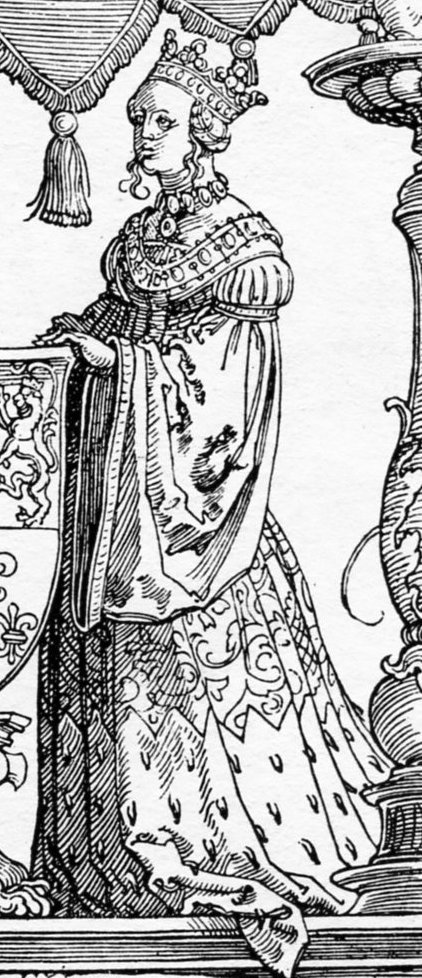My second Cranach-style gown, with matching fur-lined Goller, suitable for a noble woman in early 16th century Germany.
When I visited the USA in 1983, I bought some fabric at a ‘by the pound’ place, including three pieces of black silk velvet with an embossed cornelli pattern, which I then hoarded for a Special Occasion.

Four years later, I wanted something new and rich for Midwinter…
Research & Design
The inspiration for this gown came from the many early 16th century Cranach paintings of velvet gowns with brocade guards, including these paintings of Salome and A Woman. I wanted something interesting for the base of the skirt, and found several examples of a deep guard with a zig-zag top, as seen in this Dürer woodcut.


Source: The National Gallery

Since the gown was to be worn at Midwinter, it needed to be warm, so I decided to make a fur-lined Goller to match the gown. I wanted to highlight the cornelli design in the velvet on the Goller, to add to the rich effect.


Construction
I already had a suitable low-necked gathered Hemd to wear, so I patterned up the bodice, based on some lower class outfits I had made, with the bodice cut in one piece. (I would not do this now!) The major change was a V-shaped back (I can’t recall the inspiration for this). I patterned the sleeve sections, although I planned to make the upper sleeve using separate strips.


Once I had my patterns, I laid them on the velvet pieces to check they would fit, and that the piecing would not be too obvious. As it was, I had a good metre left over!
This also allowed me to estimate how much brocade I would need. In the days before the internet and online shopping, we were restricted to what we could find in the local fabric stores. I finally found some gold and black brocade – a bit too tinsel for my taste, but the only option available.
I attached the guards on the bodice, sleeves and skirt with machine zig-zag (to reduce fraying), then sewed narrow gold braid along the edge of the brocade to hide the construction.
Knowing no better, I knife-pleated the skirt into the bodice, with a piece of grosgrain ribbon supporting the pleats across the open front. And the Brustfleckt I made from a second-hand Indian purse, densely embroidered in gold purl in a believable pattern – so lush!


Goller
It was going to be cold, so I wanted a Goller. I patterned this based on the layout in Köhler (1963) – I was much taken with idea of the excised diamond to shape the neck. Köhler referred to examples made of rich fabrics and lined with fur, which was ideal for this purpose.
I decorated the Goller by couching down fine gold cord into the cornelli pattern in the fabric, running it over the seams to hide them, then edged it all with the gold braid. I lined it in mink, cut from a second-hand mink coat I had bought from a charity store. So warm!


Afterthoughts
I would pattern and construct this outfit SO differently now, but for the time it was a great piece and it lasted very well.
In 2002, 15 years after I made this gown, the Principality of Lochac became a Kingdom. Since I was making my husband a lush Elizabethan, I needed to manage my time. I decided to renovate this gown and wear it to the big event. I needed to tidy and stabilise the brocade in several places and deal with the worn hem by adding a new black velvet guard, but that was all. I made a new petticoat and new hat and was pleased it still looked good!
In 2010, 23 years after it’s first outing, I wore it to celebrate 30 years since the start of Australian SCA group. These days I no longer wear it, but have packed it away with a few other important ‘keepsake’ outfits.



